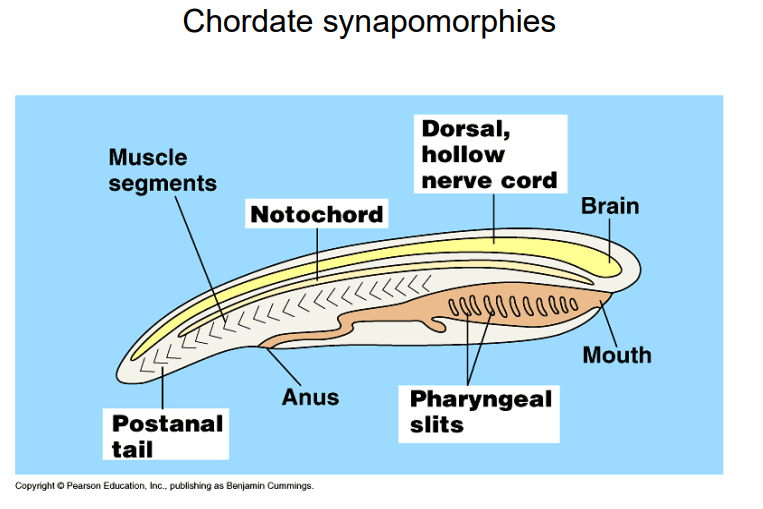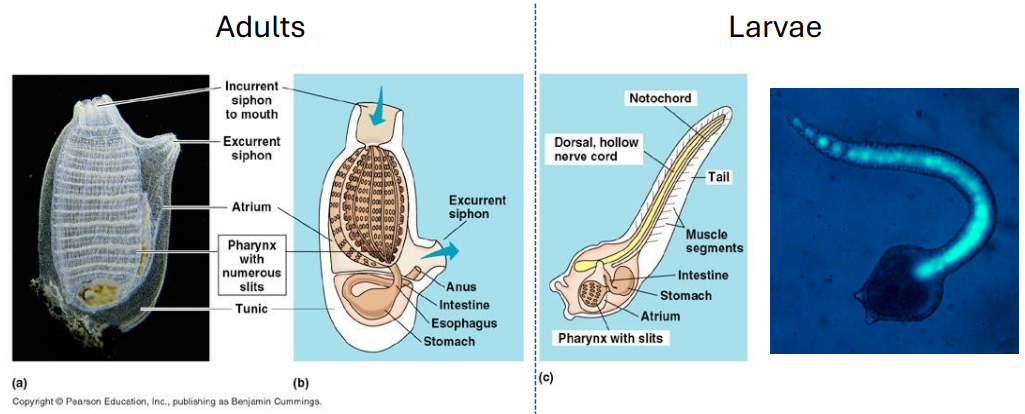Week 3: Deuterostomes
1/10
There's no tags or description
Looks like no tags are added yet.
Name | Mastery | Learn | Test | Matching | Spaced |
|---|
No study sessions yet.
11 Terms
Characteristics of Deuterostomes
Deuterostomy (blastopore = anus)
radial cleavage
Enterocoely (coeloms from archenteron)
Tripartite body (3 coeloms→ Protocoel, mesocoel, metacoel)
Gill pores
Enterocoely
coelum buds off from central cavity
Former phyla of Deuterostomia (now known to be protostomes)
Chaetognath/ Arrow worm
Radial cleavage
Trimery
Deuterostomy
Enterocoely
Brachiopods/ lamp shells
radial cleavage
trimery
enterocoely
Pogonophoran/ Vestimentiferan/ Siboglinidae
Spiral cleavage
Trimery?
Enterocoely?
(Schizocoely in Pogonophores)
Possible Phyla of Deuterstomia
(Xen)Ambulacraria
Hemichordata
Echinodermata
Xena coelomorpha
Chordata
Cephalochordata
Tunicata
Vertebrata
Chordate Synapomorphies
Notochord
dorsal, hollow nerve cord
postnatal tail
pharyngeal slits

Tunicata - Sea Squirts
No notochord/ nerve cord/ tail (attached to substrate/ rocks)
^ Body plan after metamorphosis → larvae have the right characteristics since they are mobile

Cephalochordata- Amphioxus
filter feeders but don’t attach to substrate
share many chordate synapomorphies
Morphology leads cephalochordates to be more closely related to vertebrates because they look more like fish
How are tunicates more closely related to chordates than cephalochordates?
Tunicates more closely related if you look at AA sequences→ now in a clade called olfactores
apparatus used to smell well developed in both groups
Tunicates have evolved a sessile, filter feeding lifestyle and a radically new, simple, adult bodyplan
Tunicates have lost complexity.
But their genomes are quite different from other chordates. They show chromosomal rearrangements and have lost many genes found in amphioxus and vertebrates
Genome of Cephalochordates have a genome closer to mammals → depending on the data different conclusions on how closely related animals are
→ we may come up with different conclusions based on the data we have
Ambulacraria
Hemichordates
Echinoderms
Show penta-radiality in adult life stage
How are hemichordates and echinoderms linked?
dna
shared used of isoleucine codon
in mt codon
Amino acid code AUA codes for the same thing in ophiuroids and sea stars→ not universal → codes for isoleucine instead of methionine
larval morphology
Placement of xenacoelomorpha
sister to protostomia or sister to ambulacraria
used to be placed with platyhelminthes (protostomes)→ both have a highly simplified body plan